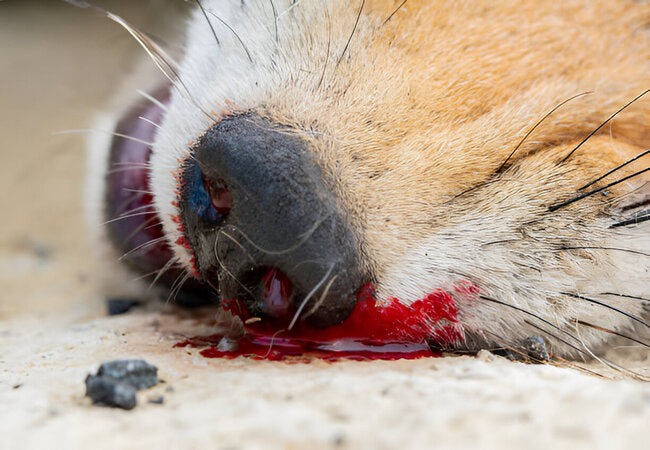2025 Vet Guide: Dog Nosebleeds – Causes, First Aid & When to See a Vet 🐶🩸

In this article
2025 Vet Guide: Dog Nosebleeds – Causes, First Aid & When to See a Vet 🐶🩸
By Dr. Duncan Houston BVSc
Nosebleeds in dogs—also known as epistaxis—are never normal and may signal anything from a simple scrape to a more serious health concern. This guide explains causes, immediate steps, diagnostics, treatments, and prevention strategies. 🛡️
🔍 1. What Is Epistaxis?
Epistaxis is bleeding from the nostrils, nasal cavity, or nasopharynx. It can range from a light drip to heavy bleeding.
⚠️ 2. Common Causes
- Trauma: Blunt or penetrating injury—most frequent cause.
- Foreign bodies: Grass awns, sticks lodged in the nasal passages.
- Tumors: Nasal cancers or growths—especially in older dogs—often cause persistent bleeding.
- Dental abscesses: Tooth root infections can leak into the nasal passages.
- Infections: Bacterial, fungal, or viral rhinitis/sinusitis.
- Clotting disorders: Von Willebrand disease, thrombocytopenia, DIC—can cause spontaneous bleeding.
- Hypertension or systemic illness: High blood pressure, liver disease, and cancers.
- Vasculitis or immune-mediated issues: Often systemic, causing intermittent bleeding.
🏥 3. First Aid Steps
- Stay calm and keep your dog quiet—excitement raises blood pressure and bleeding.
- Apply an ice pack (wrapped in cloth) to the bridge of the nose to constrict vessels.
- Don’t insert cotton or shove tissues—they can worsen bleeding.
- If bleeding lasts over 5 minutes or is heavy, seek veterinary attention immediately.
🔍 4. When to See a Vet
- Heavy, persistent, or recurrent bleeding of any amount.
- Bilateral bleeding (both nostrils), indicating a possible systemic cause.
- Signs like lethargy, disorientation, facial swelling, or breathing difficulty.
- Animal may swallow blood—vomiting or black/tarry stools could follow.
- Underlying chronic conditions (e.g., hypertension, tumor risk, breed predisposition to bleeding disorders): Dobermans, Shepherds, Corgis, etc..
🧪 5. Veterinary Diagnosis
- Detailed history and physical, including oral and nasal exam.
- Blood work: CBC, biochemistry, clotting profiles.
- Blood pressure check for hypertension causes.
- Imaging—X-rays, CT, rhinoscopy to assess the nasal cavity.
- Cytology/culture for infections; biopsy for suspected tumors or vasculitis.
🩺 6. Treatment Options
- Trauma/foreign body: Remove object, treat wounds, possibly cauterize.
- Infection: Antibiotics or antifungals as indicated.
- Dental disease: Extraction or root canal if the abscess is caused.
- Clotting issues: Transfusion, vitamin K for rodenticide, and treat the underlying disorder.
- Tumor or mass: Surgery, radiation, chemotherapy, depending on type.
- Hypertension: Treat the underlying disease and control blood pressure.
- Immune/vasculitis: Immunosuppressive therapy as prescribed.
📝 7. Prognosis & Follow-Up
Outcomes depend on cause: trauma/foreign body—often good; tumors or systemic diseases—variable; clotting disorders—requires ongoing management.
🏡 8. Prevention & Monitoring
- Supervise your dog outdoors to prevent trauma.
- Stay current with dental check‑ups and cleanings.
- Annual health screenings, especially for blood pressure and coagulation in at-risk breeds.
- Promptly treat any facial wounds or suspected sinus infections.
📱 9. Tools for Pet Parents & Vets
- Ask A Vet: Immediate triage for nosebleeds, guidance on severity.
- Woopf: Track episodes, bleeding volume, diagnostics, vet follow‑ups.
- Purrz: Monitor recurring issues, triggers, medications, and blood pressure records.
📚 FAQs
Q: Is a small trickle of blood normal after a sneeze?
No. Any blood—even a small amount—is abnormal in dogs and warrants at least a vet check‑up.
Q: Can home remedies stop the bleeding?
While ice helps, home care doesn’t treat underlying causes. Veterinary diagnostics are essential.
Q: When can I wait vs go immediately?
Heavy or persistent bleeding, bilateral flow, lethargy, facial swelling, or swallowing blood = emergency. Single nostril, mild bleed, stable dog = we can talk to your vet within hours.
💬 Owner Insight
> “My lab’s nose started bleeding after a fight. Ice calmed him, vet removed a stick fragment—it healed fast and never recurred.”
🏁 Final Thoughts from Dr Houston
Nosebleeds in dogs deserve attention—while sometimes minor, they may signal serious health issues. With prompt first aid, veterinary care, and tools like Ask A Vet, Woopf, and Purrz, you can help ensure your dog’s recovery and long-term wellness. 💙
Download the Ask A Vet app for instant guidance, tracking, and expert follow‑up. 📱
AskAVet.com – Helping you—and your dog—breathe easy again.






